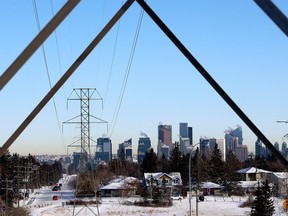
Monday morning arrived with another power grid alert in the province — the third in consecutive days — but the head of the Alberta Electric System Operator thinks we’re “through the worst of it” as temperatures moderate and more power generation is available.
But Michael Law said the unprecedented provincial emergency alert sent out on the weekend, with the AESO warning of the potential of rotating outages, highlights the need to have ample dispatchable generation during extreme periods of tight supply and rising demand.
It also illustrates just how close the province came to the precipice on Saturday night.
“We were dispatching everything that we had within the province and calling on our neighbours for emergency energy and reserves from other jurisdictions, as well as dispatching the battery facilities that we have . . . I would say it was as tight as we have ever been on the power system,” Law said Monday.
“We were up against the wall from a supply perspective. And from a timeline perspective, it was very imminent . . . We were within the half-an-hour-type time frame” of issuing rolling outages.
The situation in Alberta came as bitterly cold weather gripped the entire province and tested grid reliability over the past week.
The AESO, which manages and administers Alberta’s power system, issued an alert Monday morning as demand increased, topping 11,500 megawatts. The alert was lifted later in the morning as rising solar and wind generation offered some relief, the AESO reported.
Alberta electricity demand peaked Thursday evening, setting a new consumption record of 12,394 MW, but the night passed without any major problems.
The situation was more touch-and-go on Saturday, which led to a provincewide emergency alert warning Albertans of the potential of rotating outages.
The issue was extreme cold, too much demand and not enough supply to dispatch.
-
 Calgary weather: Extreme cold warning ended | 92 minimum records broken in four days | A fourth grid alert issued Monday
Calgary weather: Extreme cold warning ended | 92 minimum records broken in four days | A fourth grid alert issued Monday -
 Perfect storm led to last weekend’s threat of Alberta electricity blackout
Perfect storm led to last weekend’s threat of Alberta electricity blackout -
 Premiers attack Ottawa’s renewables plans as cold weather strains Alberta’s electricity grid
Premiers attack Ottawa’s renewables plans as cold weather strains Alberta’s electricity grid -
 Alberta’s utilities minister defends ‘energy-only’ power market amid blackout scare
Alberta’s utilities minister defends ‘energy-only’ power market amid blackout scare -
 How did Alberta wind up facing blackouts in the extreme cold? A Q&A with AESO
How did Alberta wind up facing blackouts in the extreme cold? A Q&A with AESO -
 Varcoe: Cold snap sends power use to new heights; growing supply from renewables opens door to future exports
Varcoe: Cold snap sends power use to new heights; growing supply from renewables opens door to future exports
However, the provincial emergency alert and some quick action by consumers to switch off appliances and lights — along with some timely electricity imports from Saskatchewan — avoided the need for temporary interruptions.
The last time Alberta saw such outages was during the 2013 floods, but that wasn’t in the dead of winter with the thermometer marooned around -40 C.
This also marked the first time Alberta used its emergency alert for an electricity supply issue, setting off cellphones in the province.
Affordability and Utilities Minister Nathan Neudorf said the decision to do so was made in combination with his department, the premier’s office and the minister of public safety.
“We felt that we were close enough to that edge, given the recommendations from the AESO, that we needed to make sure people were aware,” Neudorf said in an interview.
“I don’t want to be the boy who cried wolf and I don’t want to alarm people needlessly. It is a significant tool and should be used only in the most dire circumstances.”
The response, by all accounts, was exactly what was needed. After the alert, demand dropped by 200 MW in short order.
If there had been rolling outages, the AESO would likely have needed to shed about 100 to 200 megawatts, and distribution facility owners would have cut power to certain neighbourhoods for periods of about 20 to 30 minutes, Law said.
If demand didn’t drop and rolling outages weren’t adopted, it could have led to instability in the system and possibly uncontrolled cascading outages.
Electricity expert Blake Shaffer, an economist at the University of Calgary, applauded the response from the grid operator and said the alert “perhaps saved the day” with a sharp decline in power use Saturday night.
“I think the AESO did a marvellous job and there was no doubt a ton of stress in that control room,” said Shaffer, a former head trader at TransAlta Corp.
“The system bent, but it didn’t break.”
But how did it reach that point and what’s the solution to avoid such situations in the future? Those questions will be pondered in the days and weeks ahead.
The startup of the $1.5-billion Cascade Power Project, a new 900 MW gas-fired plant being built near Edson, is expected to be fully running by the end of the second quarter. Suncor Energy’s new $1.4-billion cogeneration project, which will provide about 800 MW, is also under construction.
Other projects are also on the go, including more than 1,500 MW of wind, solar and battery projects also in the construction lineup for this year, according to AESO.
Yet, as critics point out, installed renewable capacity doesn’t help if the wind dies down and the sun isn’t shining during the coldest days of the year.
In the shorter term, “we’re through the worst of it,” said Law, noting temperatures are forecast to increase this week and more wind generation is back online.
“I’m feeling much more confident and much more comfortable about the reliability of our system as we look forward,” he added.

The weekend alerts also highlight the need to have a portfolio of different types of supply, including sufficient dispatchable generation.
“What we need to ensure as a province going forward is that we maintain sufficient firm generation. We really did have an appropriate level (of generation) overall, barring the fact that we had a couple of big units off-line,” said AESO’s chief executive.
“But I think this is an example of why we need to ensure that we have sufficient dispatchable, dependable generation available to us as a province to meet what is always our most challenging time, which is those cold, dark winter nights.”
Chris Varcoe is a Calgary Herald columnist.
You can read more of the news on source






